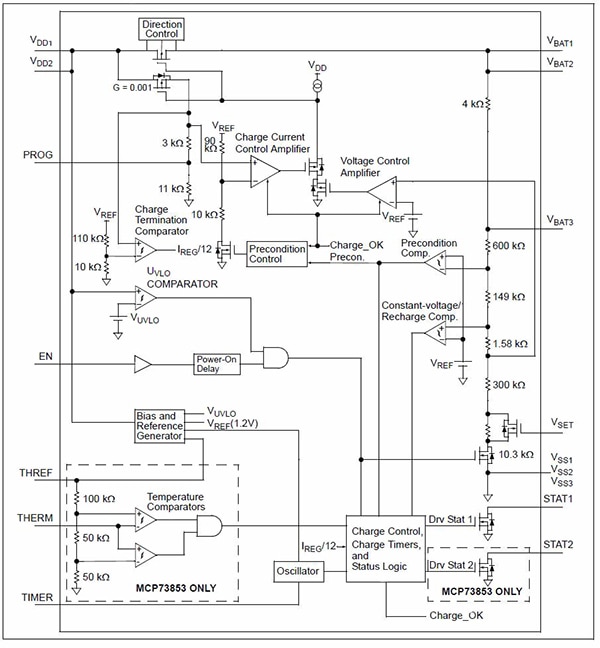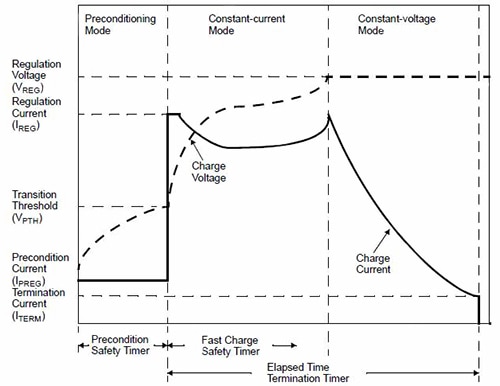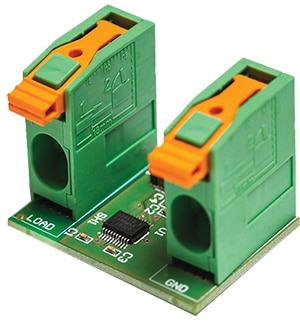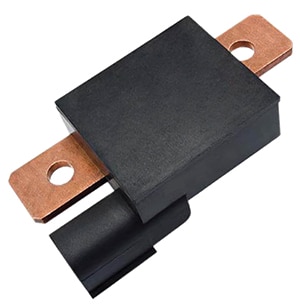Charge and Battery Control Sensors and Solutions
投稿人:电子产品
2016-05-06
Not long ago, the term "sensor" was synonymous with "transducer." However, that is no longer the case. Sensors and sensor systems have come a long way and are taking advantage of new and diverse technologies. Higher integration is yielding monolithic mixed-signal systems on a chip that can be embedded everywhere. The modern smartphone is perhaps the best example of a mass-produced, battery-powered mobile sensor array that can be accessed globally in a wireless fashion.
As older battery technologies are replaced by newer battery chemistries and architectures, sensor challenges arise. Both on-board and on-chip sensors must be optimized for a design to take advantage of the newest battery technologies. While some sensors can be as simple as a resistor, others require high resolution and mixed-signal technologies to provide more accurate data so as to ensure the long life, optimal performance, and safety of the mobile device.
This article looks at embedded sensors as part of an integrated solution for optimizing and protecting battery-based designs. Both stand-alone and peripheral topologies will be discussed using specific parts as examples. All parts and technologies referenced here can be found on the Digi-Key website.
Battery controllers
Electronics for modern battery-powered systems should be able to operate in two states; while line power is available, and when it is not. While line power is connected, operational power as well as charge power is metered, monitored, and controlled. When disconnected from line power, battery-only energy is used and should be carefully monitored. The protection schemes employed can be distributed between the chargers and the handheld or mobile units themselves, and each should hold the specific sensors and protect against the conditions they are potentially exposed to.
For example, battery-powered systems are line isolated and will not be subjected to power-line surges and spikes. These types of sensing and suppression components may not be needed in the handheld and mobile design. However, these should be used in a charge cradle since line faults can potentially propagate through circuits and take out unprotected batteries.
Modern battery technologies may pose other challenges for battery-based sensors that were not issues of concern in the past. For example, many new battery technologies in current use have been known to ignite and flare up rapidly at very high temperatures when stressed in certain ways. Designers may need to implement new battery system designs to include real-time temperature monitoring of each individual cell in the battery array. Older, intrinsically safer battery technologies would never require this.
Many of the newer battery management chips incorporate special-purpose hardware specific to a particular battery technology. For example, the Microchip MCP73855T-I/MF targets Lithium Ion and Lithium Polymer battery technologies providing a 400 mA rapid charge, constant-voltage single-cell solution that includes individual cell temperature monitoring as well as overcurrent sensors.
The MCP73855 parts are targeting low-cost and space-limited designs. The 16-lead 4 mm x 4 mm package houses a stand-alone linear implementation for charge management and control (Figure 1).

Figure 1: Highly integrated stand-alone charge and safety controllers for specific modern battery chemistries integrate sensors as part of the charge management algorithms. Thresholds, rates, and timeouts are typically performed using external bias components.
Some nice features include a cell preconditioning mode that allows precise control over trickle charge rate, thresholds, and timeouts using external resistor selection. This can act as a safety check before entering the constant-current charge mode (Figure 2). Another benefit to choosing this part is the access to EDA and CAD models.

Figure 2: Precharge safety modes allow generation of fault flags and cessation of constant-current charging modes unless safety checks pass. Thresholds and timeouts are programmable through external bias resistors. Note that this plot does not contain temperature-dependent waveform control.
The stand-alone Microchip Technology MCP73855T-I/MF can provide status outputs of alert and alarm conditions and be digitally enabled and disabled. This allows switch controls to disable the part automatically when no battery is inserted in the charger. This also permits LED status indicators for the user to monitor.
Adding an MCU
Higher levels of control and functionality are possible when using charge peripheral devices coupled with a local microcontroller. Take for instance the AMS AS8510-ASSM that is designed to be an ideal solution for digitally controlled and monitored shunt-based battery sensors.
This part features an integrated pass transistor to reduce component count and a high accuracy (+/- 0.5 percent) preset voltage regulator. It also includes two digitally filtered 16-bit Sigma Delta A/D converters as well as a programmable current source for use with external temperature sensors. Either a single differential temperature sensor can be used, or two single-ended sensors or an integrated internal temperature can be multiplexed into the A/D conversion stage to provide the most flexibility.
A unique feature of this part is the ability to bypass the Programmable Gain Amplifier (PGA) when performing system-error compensation. By eliminating the PGA in the signal chain, gain drift is eliminated as a source of error. As a result, differential battery plus and battery ground signal paths solely rely on the production trimmed internal Vref.
Note, all of this functionality can realistically only be implemented if an intelligent microcontroller is put in charge. In this case, the AMS AS8510-ASSM and all its settings, controls, and data are accessible in pure digital format thanks to the serial SPI interface. By becoming a charge controller and sensor peripheral, a higher level of more granular control can be attained. Sensor monitoring and charge controlling can be a background task of a host controller, but will involve the extra steps of coding for that host micro.
Simplifying learning and reducing development time, the AMS AS8510 DEMOBOARD uses a simple USB interface and a PC-based GUI to access all device registers and special settings. Included in this development solution are code demos that can help reduce learning and coding times.
The AMS AS8510 COPPER SHUNT MINI BOARD tests and demonstrates this copper-shunt approach and also demonstrates the current measurement with thermal-coefficient compensation. Both internal and copper-meander thermal sensors can be selected as measurement paths and this compact little unit handles up to 60 A (Figure 3).

Figure 3: Low-cost off-the-shelf modules allow fast testing and development. This one implements thermal coefficient compensation for loads up to 60 amps and uses an SPI interface for easy connection to an embedded controller.
AMS also has an instructional video using this technology called "Shaping the World with Sensor Solutions."
While many battery designs target smaller handheld applications with limited burst levels of current, higher-power battery sensors can also present challenges. Higher voltage and higher-current techniques can use shunted and isolated design approaches, but these can add cost and impose space constraints.
For example, a 0.01 ohm resistor used as a current sensor with a 1000 amp range will present a 10 volt full-scale range which is easily attenuated and usable for most any mixed-signal microcontroller. However, that same unit will require a 10,000 watt part which is no small feat.
Specialized sensors exist for higher-power monitoring and protection of energy cells and batteries. One such example comes from Vishay with its WBPK600L0A00010001 battery sensor (Figure 4).

Figure 4: Power sensors for modern high-current battery-based applications include series sensors like this part that can handle up to 600 amps continuous or 2,000 amps pulsed power using a serial bus for communications.
In order to be able to pass high currents, a very-low resistance of 100 microOhms is placed in series with the current flow of the battery which can be from 4 to 18 volts. Note the high-current values this part supports. A 600 amp continuous current flow can be monitored, or up to 2000 amps of pulsed power can pass through this battery sensor.
The low (<5 nH) inductance helps limit flyback intensity and the ruggedized automotive-capable sealed packaging operates from –40 to +155°C. This part uses a serial LIN interface and acts as a slave device that can remotely be accessed and programmed to set a variable sampling rate.
In summary, batteries are not what they used to be and sensors for batteries have had to adapt to provide safe and effective battery usage. While new technologies like thermally expanding internal contacts are being developed to help protect batteries from exploding at over-temperature conditions, it is and will remain in the foreseeable future up to sensor-based solutions to protect batteries, devices, and users. So it is important not to take your battery management, control, and sensing too lightly.
For more information about the parts discussed in this article, use the links provided to access product pages on the Digi-Key website.
免责声明:各个作者和/或论坛参与者在本网站发表的观点、看法和意见不代表 DigiKey 的观点、看法和意见,也不代表 DigiKey 官方政策。








